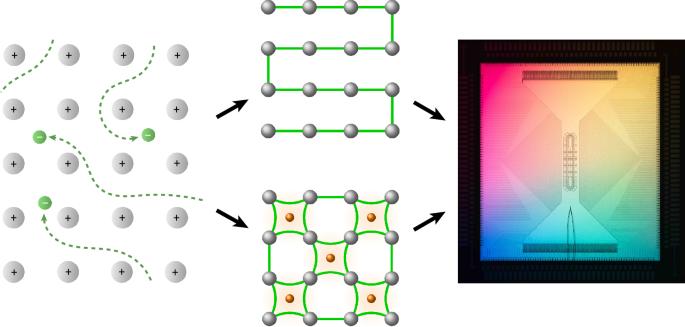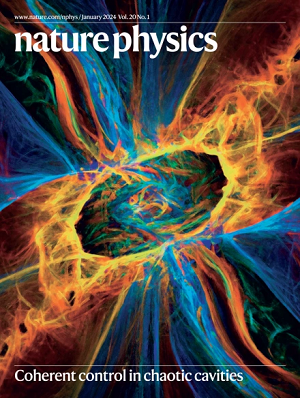Experimental demonstration of breakeven for a compact fermionic encoding
IF 18.4
1区 物理与天体物理
Q1 PHYSICS, MULTIDISCIPLINARY
引用次数: 0
Abstract
Solving the Fermi–Hubbard model is a central task in the study of strongly correlated materials. Digital quantum computers can, in principle, be suitable for this purpose, but have so far been limited to quasi-one-dimensional models. This is because of exponential overheads caused by the interplay of noise and the non-locality of the mapping between fermions and qubits. Here we use a trapped-ion quantum computer to experimentally demonstrate that a recently developed local encoding can overcome this problem. In particular, we show that suitable reordering of terms and application of circuit identities—a scheme called corner hopping—substantially reduces the cost of simulating fermionic hopping. This enables the efficient preparation of the ground state of a 6 × 6 spinless Fermi–Hubbard model encoded in 48 physical qubits. We also develop two error mitigation schemes for systems with conserved quantities, based on local postselection and on extrapolation of local observables, respectively. Our results suggest that Fermi–Hubbard models beyond classical simulability can be addressed by digital quantum computers without large increases in gate fidelity. Digital quantum simulations of fermionic models have so far been based on the Jordan–Wigner encoding, which is computationally expensive. An alternative and more efficient encoding scheme is now demonstrated in a trapped-ion quantum computer.


紧凑费米子编码的收支平衡实验证明
求解费米-哈伯德模型是强相关材料研究的中心任务。原则上,数字量子计算机可以适用于这一目的,但迄今为止仅限于准一维模型。这是因为噪声的相互作用以及费米子和量子位之间映射的非局部性造成了指数级的开销。在这里,我们使用捕获离子量子计算机实验证明了最近开发的局部编码可以克服这个问题。特别地,我们证明了适当的术语重新排序和电路标识的应用-一种称为角跳的方案-大大降低了模拟费米子跳的成本。这使得用48个物理量子位编码的6 × 6无自旋费米-哈伯德模型的基态得以有效制备。我们还开发了两种基于局部后选择和局部观测外推的守恒量系统的误差缓解方案。我们的研究结果表明,超越经典可模拟性的费米-哈伯德模型可以通过数字量子计算机解决,而无需大幅增加门保真度。
本文章由计算机程序翻译,如有差异,请以英文原文为准。
求助全文
约1分钟内获得全文
求助全文
来源期刊

Nature Physics
物理-物理:综合
CiteScore
30.40
自引率
2.00%
发文量
349
审稿时长
4-8 weeks
期刊介绍:
Nature Physics is dedicated to publishing top-tier original research in physics with a fair and rigorous review process. It provides high visibility and access to a broad readership, maintaining high standards in copy editing and production, ensuring rapid publication, and maintaining independence from academic societies and other vested interests.
The journal presents two main research paper formats: Letters and Articles. Alongside primary research, Nature Physics serves as a central source for valuable information within the physics community through Review Articles, News & Views, Research Highlights covering crucial developments across the physics literature, Commentaries, Book Reviews, and Correspondence.
 求助内容:
求助内容: 应助结果提醒方式:
应助结果提醒方式:


